Dogs Chained Up
Do the RSPCA condone chaining up dogs? YES!!
Press Release from SHG: RSPCA ATTEMPTS TO CENSOR THE INTERNET AND SUPPRESS CRITICISM. NB: we are not responsible for the content on external websites.
OCT 1st 2009 STOP PRESS: The legal team from the UK's largest and richest animal welfare charity, have today contacted this rescue threatening to sue for Trademark Infringement for using the acronym that is their name. If you have made a will that contains this acronym, please contact your solicitor immediately to make sure you don't infringe their trademark. We have checked and it is OK to replace offending acronym with 'CINNAMON TRUST'. Robert Killick writing for Our Dogs Says
AUGUST 2009 - Sadly Bruno had to be put to sleep last week after a lifetime of neglect. He was sold to the rescue for £200 (the only way we could get him out) but was suffering from advanced lymphoma and kidney failure. The owner knew the dog was ill but had not taken him to a vet. Lulu has disappeared. The puppy was also sold to the rescue for £150 and is safe. Fluffy, however, is being subjected to the same level of neglect that poor Bruno and Lulu suffered and winter is on its way. Fluffy now at risk
Three GSD's - Bruno an old boy, a 6mth old GSD puppy and now a new dog we have called Fluffy are chained up in a small yard, no bedding, no shelter and no drinking water.
From the forum: Re: Desperate Situation
by 007 on 03 Jul 2009 11:35
its thunder and lightning here now, Bruno, pup and fluffy dog barking with fright, Crotty must have just come out the house and hit them as we have just heard them screaming.....
This case has been ongoing now for over a year. The RSPCA have previously visited and state: 'we do not believe that overall, this constitutes a lack of care or a breach under Section 9 of the AWA which deals with the animals' needs.'
On Monday 29th June, a rescue volunteer visited the address where these dogs are kept. Lulu has apparently disappeared but another dog we have called Fluffy was there along with Bruno and puppy. The temperatures yesterday were in the 20's and set to rise further this week. All 3 dogs were chained, no shelter - the door to the red shed was firmly shut tight. They have no bedding and there was no food or drinking water available to the dogs. These dogs have been monitored for over a year now and we can categorically say that these dogs may as well be dead rather than be condemned by the RSPCA to live life like this. RSPCA, you should hold your heads in shame.
All 3 dogs were chained
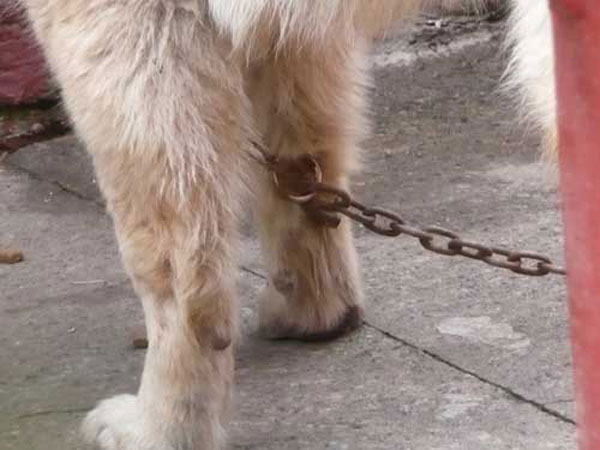
Remember that the RSPCA state: 'we do not believe that overall, this constitutes a lack of care or a breach under Section 9 of the AWA which deals with the animals' needs.'
What life do these dogs have? NONE!!
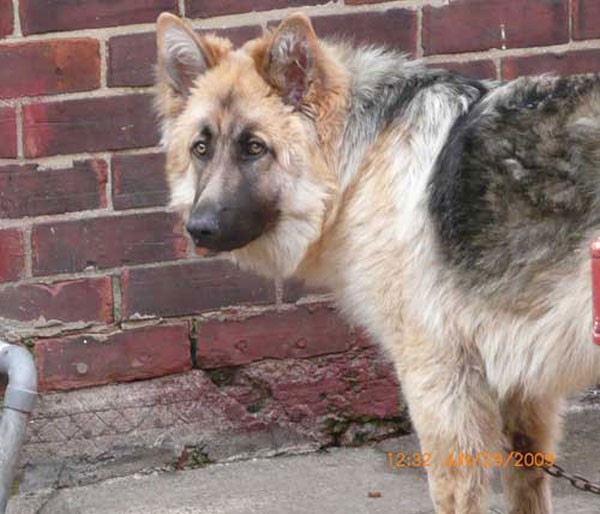
None of these dogs is walked - they spend 24/7 on short chains in this yard. We understand that the new male has been picking on old Bruno. We assume that these are 3 entire males which will inevitably lead to problems
Bruno - asleep chained last year. Bruno is now DEAD!
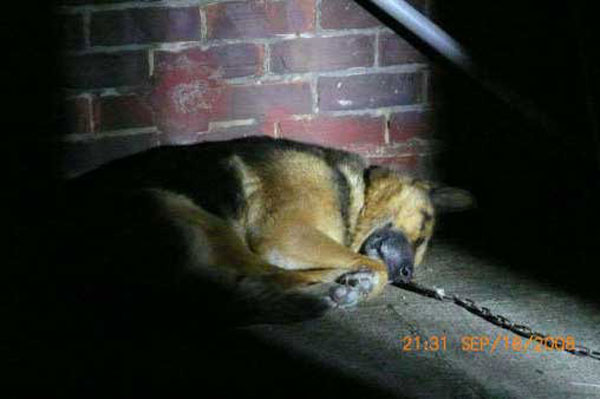
Bruno was an old dog, he probably was not as old as he looks as he has had such an appalling life. His back legs were not good. He had no soft bedding to ease the pain of his old bones. We paid the evil owner £200 to get Bruno out but he was suffering advanced lymphoma and kidney failure. At least Bruno died with dignity and not just left out on the cold hard concrete to suffer!
Lulu - 5-star luxury
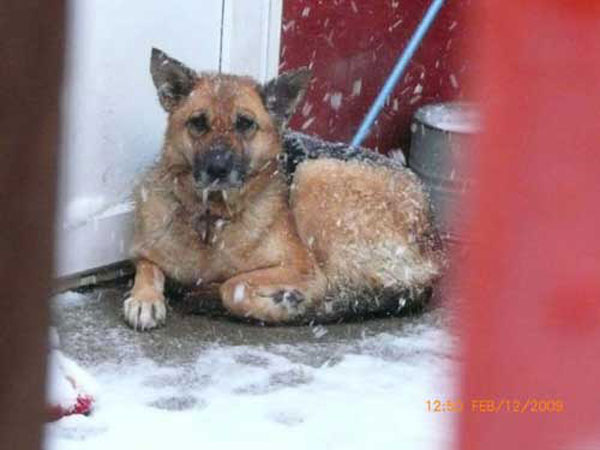
Still, accept that this doesn't breach Section 9 of the AWA!!!
This was Lulu's summer home - note the chain
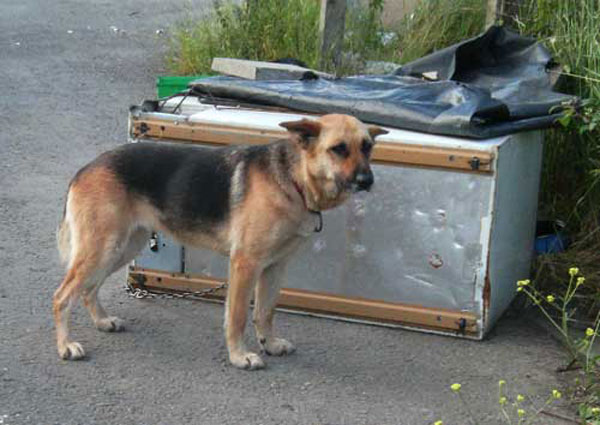
Lulu has disappeared but there are 3 other dogs suffering abuse at the hands of Mr James Brendan Seamus Crotty. We have also been informed that he kicks and beats the dogs and that they are regularly heard crying.
Message from The Humane Society to the Inhumane RSPCA
The Facts About Chaining or Tethering Dogs
Continuously chaining a dog is inhumane and dangerous.
1. What is meant by "chaining" or "tethering" dogs?
These terms refer to the practice of fastening a dog to a stationary object or stake, usually in the owner's backyard, as a means of keeping the animal under control. These terms do not refer to the periods when an animal is walked on a leash.
2. Is there a problem with continuous chaining or tethering?
Yes, the practice is both inhumane and a threat to the safety of the confined dog, other animals and humans.
3. Why is tethering dogs inhumane?
Dogs are naturally social beings who thrive on interaction with human beings and other animals. A dog kept chained in one spot for hours, days, months or even years suffers immense psychological damage. An otherwise friendly and docile dog, when kept continuously chained, becomes neurotic, unhappy, anxious and often aggressive. In many cases, the necks of chained dogs become raw and covered with sores, the result of improperly fitted collars and the dogs' constant yanking and straining to escape confinement. Dogs have even been found with collars embedded in their necks, the result of years of neglect at the end of a chain. In one case, a veterinarian had to euthanise a dog whose collar, an electrical cord, was so embedded in the animal's neck that it was difficult to see the plug.
4. Who says tethering dogs is inhumane?
In addition to The Humane Society of the United States and numerous animal experts, the U. S. Department of Agriculture issued a statement in the July 2, 1996, Federal Register against tethering:
"Our experience in enforcing the Animal Welfare Act has led us to conclude that continuous confinement of dogs by a tether is inhumane. A tether significantly restricts a dog's movement. A tether can also become tangled around or hooked on the dog's shelter structure or other objects, further restricting the dog's movement and potentially causing injury."
5. How does tethering or chaining dogs pose a danger to humans?
Dogs tethered for long periods can become highly aggressive. Dogs feel naturally protective of their territory; when confronted with a perceived threat, they respond according to their fight-or-flight instinct. A chained dog, unable to take flight, often feels forced to fight, attacking any unfamiliar animal or person who unwittingly wanders into his or her territory.
Numerous attacks on people by tethered dogs have been documented. For example, a study published in the September 15, 2000, issue of the Journal of the American Veterinary Medical Association reported that 17 percent of dogs involved in fatal attacks on humans between 1979 and 1998 were restrained on their owners' property at the time of the attack. Tragically, the victims of such attacks are often children who are unaware of the chained dog's presence until it is too late. Furthermore, a tethered dog who finally does get loose from his chains may remain aggressive and is likely to chase and attack unsuspecting passersby and pets.
6. Why is tethering dangerous to dogs?
In addition to the psychological damage wrought by continuous chaining, dogs forced to live on a chain make easy targets for other animals, humans, and biting insects. A chained animal may suffer harassment and teasing from insensitive humans, stinging bites from insects, and, in the worst cases, attacks by other animals. Chained dogs are also easy targets for thieves looking to steal animals for sale to research institutions or to be used as training fodder for organised animal fights. Finally, dogs' tethers can become entangled with other objects, which can choke or strangle the dogs to death.
7. Are these dogs dangerous to other animals?
In some instances, yes. Any other animal that comes into their area of confinement is in jeopardy. Cats, rabbits, smaller dogs and others may enter the area when the tethered dog is asleep and then be fiercely attacked when the dog awakens.
8. Are tethered dogs otherwise treated well?
Rarely does a chained or tethered dog receive sufficient care. Tethered dogs suffer from sporadic feedings, overturned water bowls, inadequate veterinary care, and extreme temperatures. During snow storms, these dogs often have no access to shelter. During periods of extreme heat, they may not receive adequate water or protection from the sun. What's more, because their often neurotic behaviour makes them difficult to approach, chained dogs are rarely given even minimal affection. Tethered dogs may become "part of the scenery" and can be easily ignored by their owners.
9. Are the areas in which tethered dogs are confined usually comfortable?
No, because the dogs have to eat, sleep, urinate and defecate in a single confined area. Owners who chain their dogs are also less likely to clean the area. Although there may have once been grass in an area of confinement, it is usually so beaten down by the dog's pacing that the ground consists of nothing but dirt or mud.
10. But how else can people confine dogs?
The HSUS recommends that all dogs be kept indoors at night, taken on regular walks, and otherwise provided with adequate attention, food, water and veterinary care. If an animal must be housed outside at certain times, he should be placed in a suitable pen with adequate square footage and shelter from the elements.
11. Should chaining or tethering ever be allowed?
To become well-adjusted companion animals, dogs should regularly interact with people and other animals and should receive regular exercise. It is an owner's responsibility to properly restrain her dog, just as it is the owner's responsibility to provide adequate attention and socialisation. Placing an animal on a restraint to get fresh air can be acceptable if it is done for a short period. However, keeping an animal tethered for long periods is never acceptable.
12. If a dog is chained or tethered for a period of time, can it be done humanely?
Animals who must be kept on a tether should be secured in such a way that the tether cannot become entangled with other objects. Collars used to attach an animal should be comfortable and properly fitted; choke chains should never be used. Restraints should allow the animal to move about and lie down comfortably. Animals should never be tethered during natural disasters such as floods, fires, tornadoes, hurricanes or blizzards.
13. What about attaching a dog's leash to a "pulley run"?
Attaching a dog's leash to a long line—such as a clothesline or a manufactured device known as a pulley run—and letting the animal have a larger area in which to explore is preferable to tethering the dog to a stationary object. However, many of the same problems associated with tethering still apply, including attacks on or by other animals, lack of socialisation and safety.
14. What can be done to correct the problem of tethering dogs?
More than 100 communities in more than 30 states have passed laws that regulate the practice of tethering animals. Maumelle, Ark., and Tucson, Ariz., completely prohibit the unattended tethering of dogs. Many other communities only allow tethering for limited periods of time or during certain conditions. Orange County, Fla., for example, does not allow tethering between 9 a.m. and 5 p.m. or during times of extreme weather.
15. Why should a community outlaw the continuous chaining or tethering of dogs?
Animal control and humane agencies receive countless calls every day from citizens concerned about animals in these cruel situations. Animal control officers, paid at taxpayer expense, spend many hours trying to educate pet owners about the dangers and cruelty involved in this practice.
A chained animal is caught in a vicious cycle; frustrated by long periods of boredom and social isolation, he becomes a neurotic shell of his former self—further deterring human interaction and kindness. In the end, the helpless dog can only suffer the frustration of watching the world go by in isolation—a cruel fate for what is by nature a highly social animal. Any city, county, or state that bans this practice is a safer, more humane community.
We acknowledge that RSPCA is a registered trademark registered to the Royal Society for The Prevention of Cruelty to Animals. We are not using this trademark in the course of trade but simply to make a statement.
Donations are always welcome
Please help us by making a donation so that we can help re home more unwanted German Shepherd Dogs. Donations can be sent to Jayne Shenstone, German Shepherd Dog Rescue, Little Vauld, Marden Hereford HR1 3HA. We also accept Paypal payments - just click on the Paypal button below. Thankyou.

